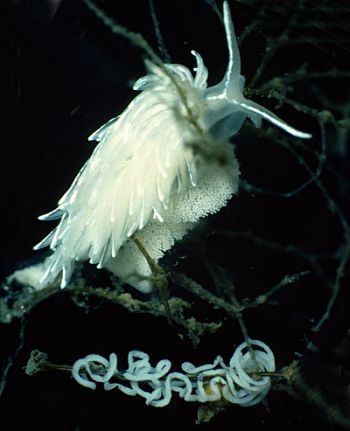
Favorinus blianus
Lemche & Thompson, 1974
Order: NUDIBRANCHIA
Suborder: AEOLIDINA
Family: Glaucidae
DISTRIBUTION
Known from the European Atlantic from Norway to NW Spain. Reported here from Rhode Island, USA.
PHOTO
UPPER RIGHT: F. blianus feeding on eggs of
?Acanthodoris pilosa with its own spawn below. LOWER RIGHT: Close-up of head to show rhnophoral swellings. April 1978 - Mulroy Bay, Co Donegal, Ireland. Photos: B.E. Picton.
LOWER LEFT: Fort Wetherhill, Jamestown, Rhode Island. [USA, Atlantic coast]. 2-3 cm long. Photo: Paul Young.
Translucent body with opaque white pigmentation forming a chracteristic pattern. There is a line down each oral tentacle which extend onto the head a join in the midline running back between the rhinophores as a single median line, which stops at about the heart. There is a medio-dorsal line along the posterior foot and a white line along the dorsal face of each ceras. The rhinophores have 3 rounded ridges or 'ring-shaped swellings'.
Reference:
• Lemche, H. & Thompson, T.E. (1974) Three opisthobranch gastropods new to the British Fauna. Proceedings of the Malacological Society of London, 41: 185-192.
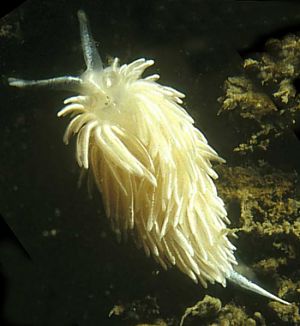
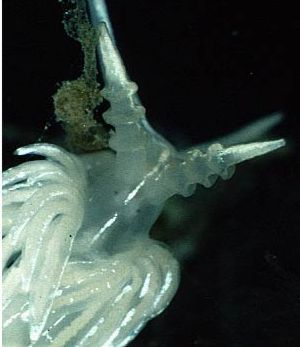
Rudman, W.B., 2001 (June 20) Favorinus blianus Lemche & Thompson, 1974. [In] Sea Slug Forum. Australian Museum, Sydney. Available from http://www.seaslugforum.net/find/favoblia
Related messages
Re: Favorinus blianus from Norway
October 12, 2007
From: Jim Anderson
Concerning message #20917:
It certainly looks like Favorinus blianus to me and similar to several I have here. See: http://www.scottishnudibranchs.co.uk/favorinus-blianus.html
Cheers
Jim Anderson
jander4454@gmail.com
Anderson, J, 2007 (Oct 12) Re: Favorinus blianus from Norway. [Message in] Sea Slug Forum. Australian Museum, Sydney. Available from http://www.seaslugforum.net/find/20941Thanks Jim,
Bill Rudman
Re: Favorinus blianus from Norway
October 11, 2007
From: Jussi Evertsen
Concerning message #20917:
Hi Christian and Bill,
I do agree that this probably is Favorinus blianus. Here along the Norwegian coast it has been found from the Swedish border north to Bodø, so it is not really that uncommon.
Jussi
jussi.evertsen@bio.ntnu.no
Evertsen, J., 2007 (Oct 11) Re: Favorinus blianus from Norway. [Message in] Sea Slug Forum. Australian Museum, Sydney. Available from http://www.seaslugforum.net/find/20935Thanks Jussi,
Bill Rudman
Favorinus blianus from Norway
October 10, 2007
From: Christian Skauge
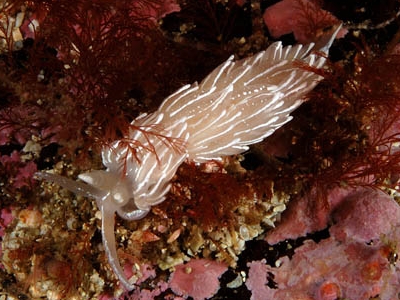
Hi Bill,
I was sifting through some older pictures of species I have not been able to identify, and came across this image. Do you think this might be a Favorinus blianus - or is it just a pale Flabellina lineata? Location is at Gulen on the Norwegian west coast in May 2005.
Christian
post@dykkefoto.no
Skauge, C., 2007 (Oct 10) Favorinus blianus from Norway. [Message in] Sea Slug Forum. Australian Museum, Sydney. Available from http://www.seaslugforum.net/find/20917Dear Christian,
It certainly looks like that species. My only doubt is that I can't see enough detail in the shape of the rhinophores. If it is F. blianus it is nice to get another record of this rarely reported species.
Best wishes,
Bill Rudman
Favorinus blianus from Scotland
May 14, 2007
From: Jim Anderson
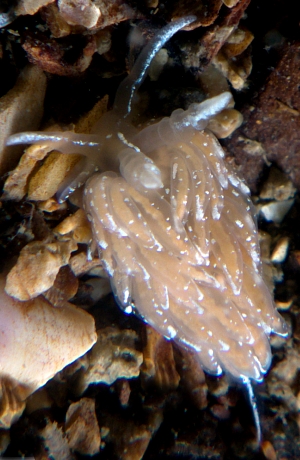
Dear Bill,
Here is a photo of Favorinus blianus I took on a recent dive.
Locality: Dunollie Point, Oban on the west coast of Scotland. On the south side of the point on shingle/hydroid sloping bottom with lots of small spawn on the hydroids, this animal, approx. 15 mm, was found at 16 metres. Water temperature 10°C. 10 May, 2007. Photo: J. Anderson.
Regards,
Jim A
jander4454@gmail.com
Anderson, J., 2007 (May 14) Favorinus blianus from Scotland. [Message in] Sea Slug Forum. Australian Museum, Sydney. Available from http://www.seaslugforum.net/find/19906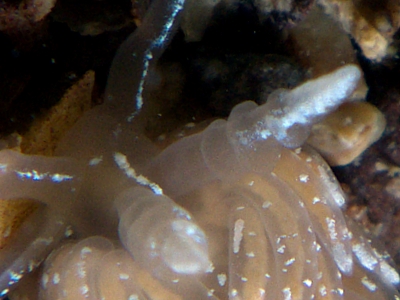
Thanks Jim,
I've included a close-up to show the shape of the rhinophores
Best wishes,
Bill Rudman
Favorinus blianus feeding
September 4, 2006
From: Jim Greenfield
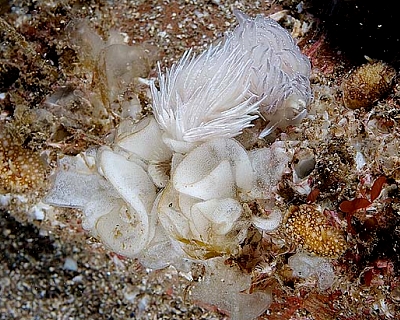
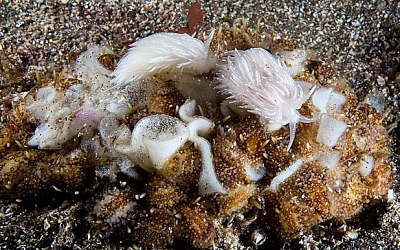
Spotted four pairs of Favorinus blianus in the North Sea. I never saw one singly. All were on spawning masses of Onchidoris bilamellata (of which there were colossal numbers).
Location - Pettico Wick on the NW side of St. Abbs Head, about 35 miles south of Edinburgh. 17 m, Scotland, UK, North Sea, 30 July 2006, Small stony outcrops on clean sand. Length: approx 20 mm. Photographer: Jim Greenfield.
Jim Greenfield.
jimgreenfield@ntlworld.com
Greenfield, J., 2006 (Sep 4) Favorinus blianus feeding. [Message in] Sea Slug Forum. Australian Museum, Sydney. Available from http://www.seaslugforum.net/find/17738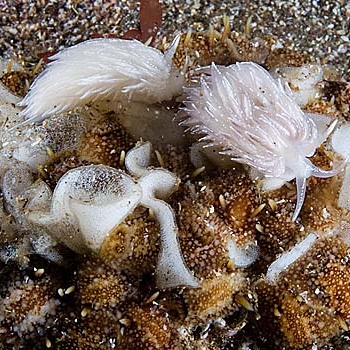
Dear Jim,
Thanks for this interesting observation. Certainly from earlier messages on the Forum this is the time Onchidoris bilamellata spawns in Scotland - at least on the west coast - so this observation suggests it does the same on the east coast as well. In your photo you can clearly see the packed Onchidoris as well as the Favorinus. Species of Favorinus all feed on opisthobranch eggs so its not surprising they are taking advantage of such an abundant source of eggs. I really can't comment on them being in pairs. I guess they are both attracted to the egg masses, but why not in threes or fours?
Best wishes,
Bill Rudman
Re: Favorinus blianus from Scotland
July 28, 2004
From: Jim Anderson
Dear Bill,
Concerning your question [#12704]. The Favorinus blianus were found 'out in the open' but with plenty of spawn within 1 metre. I did find a couple of F. branchialis in separate but adjacent spawn of Onchidoris bilamellata.
I am trying to get back down to the east coast to a site 1km from the site where these were spotted , in the near future to check for F. blianus. If I have any success I will keep you posted.
Kind regards,
Jim A.
jander4454@blueyonder.co.uk
Anderson, J., 2004 (Jul 28) Re: Favorinus blianus from Scotland. [Message in] Sea Slug Forum. Australian Museum, Sydney. Available from http://www.seaslugforum.net/find/12705Thanks Jim,
Bill Rudman
Favorinus blianus from Scotland
July 27, 2004
From: Jim Anderson
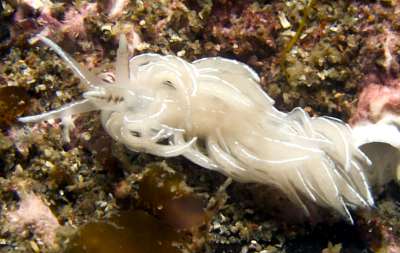
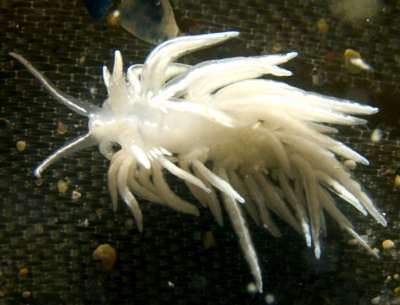
Dear Dr. Rudman,
I found these Favorinus blianus during 2 dives around high water on Sunday 18 July 04 at Weasel Loch, Eyemouth on the east coast of Scotland, the west of the North Sea. There were several animals seen, approx 8 in number and all approx. 22mm in length and at depths from 8 - 14 metres with lots of spawn from Polycera quadrilineata and masses of Onchidoris bilamellata and spawn. The water temperature was 13.5 deg C.
It is wonderful to have the Forum back and you are to be congratulated on your dedication and efforts.
Jim Anderson
jander4454@blueyonder.co.uk
Anderson, J., 2004 (Jul 27) Favorinus blianus from Scotland. [Message in] Sea Slug Forum. Australian Museum, Sydney. Available from http://www.seaslugforum.net/find/12704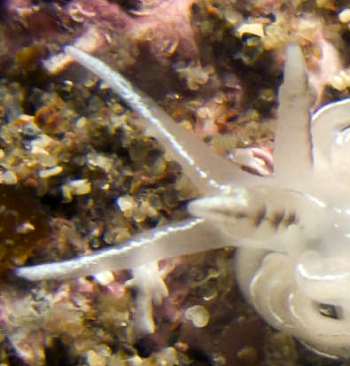
Thanks Jim,
Any records of this rarely reported species are welcome. Did you actually seeing them on, or feeding on the egg masses? I am also interested to see the black markings on the posterior side of the rhinophores in one animal. I don't recall seeing any mention of that colour in the few published accounts of the species so that is a useful bit of additional information
Best wishes
Bill Rudman
Re: Favorinus blianus
July 2, 2001
From: Bernard Picton

Hi Bill,
I'm sure your identification of Favorinus blianus from the American East Coast is correct - certainly an interesting find given the low diversity of nudibranchs in that region. It is a rather scarce animal with us, presumably feeding on other nudibranch egg masses limits its abundance and of course it was only described in 1976. Normally I only find solitary individuals. The white lines can break up into dotted lines, both on the body, cerata and tentacles in some individuals, but the overall body shape and the way the cerata are held are quite characteristic.
I've attached a few scans:
UPPER RIGHT: - Apr 1978 - Mulroy Bay, Co Donegal, Ireland - feeding on eggs of ?Acanthodoris pilosa - with Favorinus blianus spawn at bottom of photo.
LOWER RIGHT: close-up of Mulroy bay animal to show head and rhinophores.
LOWER LEFT: - Aug 1985 - Stac Lee, St Kilda, NW Scotland'
Bernard
bernard.picton.um@nics.gov.uk

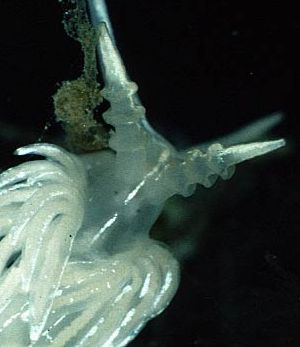
Dear Bernard,
I meant to draw attention to the food of species of Favorinus. It would be interesting to see if F. blianus would eat the spawn of opisthobranchs with coloured, rather than white, eggs, and if so how its colour would change.
[I have digitally altered your top right photo by moving the eggs of F. blianus to the right of their real position - Bill Rudman]
Best wishes,
Bill Rudman
Re: Favorinus blianus
July 2, 2001
From: Terry Gosliner
Dear Bill,
I agree with your identification of the white 'Flabellina' from Rhode Island as Favorinus blianus.
Good call.
Terry
tgosline@CalAcademy.org
Gosliner, T. , 2001 (Jul 2) Re: Favorinus blianus. [Message in] Sea Slug Forum. Australian Museum, Sydney. Available from http://www.seaslugforum.net/find/4711Favorinus blianus - first record from W. Atlantic
June 21, 2001
From: Paul Young

We're not sure if this is another Flabellina salmonacea. It was photographed at Fort Wetherhill, Jamestown, Rhode Island. [USA, Atlantic coast].
The animal is 2-3 cm long.
Paul Young
young@underwater.org
Young, P., 2001 (Jun 21) Favorinus blianus - first record from W. Atlantic. [Message in] Sea Slug Forum. Australian Museum, Sydney. Available from http://www.seaslugforum.net/find/4624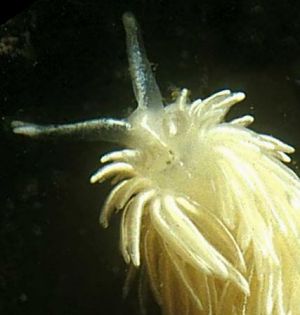
Dear Paul,
When I first saw this photo the white Y-shaped pattern on the head reminded me of Flabellina lineata which is only known from the northeastern Atlantic. However after a couple of days thinking about it I am pretty sure it is another species, Favorinus blianus which as far as I know is another species which has only been found in the northeastern Atlantic.
The only thing I am not quite sure of is the shape of the rhinophores, which in F. blianus have three large swollen rings. The shape is not clear in your photo [which I've enlarged alongside] but there does appear to be a large swelling below the white tips which could be the rings contracted into a 'lump'. If you have another photo which shows the rhinophores more clearly it would be very welcome.
I am very glad I asked you to share some of your photos with us. They are certainly proving to be very interesting.
best wishes,
Bill Rudman
